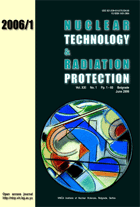
ELECTROCHEMICAL STUDIES ON STRESS CORROSION CRACKING OF INCOLOY-800 IN CAUSTIC SOLUTION
Part II: Precracking samples

June 2006
UDC 621.039+614.876:504.06
YU ISSN 1451-3994
....Back to Contents
Pages: 34 - 40
Authors: Alice DINU, Marioara ABRUDEANU, Maria RADULESCU, Lucian VELCIU
AbstractStress corrosion cracking (SCC) in a caustic medium may affect the secondary circuit tubing of a CANDU NPP cooled with river water, due to an accidental formation of a concentrated alkaline environment in the areas with restricted circulation, as a result of a leakage of cooling water from the condenser. To evaluate the susceptibility of Incoloy-800 (used to manufacture steam generator tubes for CANDU NPP) to SCC, some accelerated corrosion tests were conducted in an alkaline solution (10% NaOH, pH = 13). These experiments were performed at ambient temperature and 85°C. We used the potentiodynamic method and the potentiostatic method, simultaneously monitoring the variation of the open circuit potential during a time period (Ecorr/time curve). The C-ring method was used to stress the samples. In order to create stress concentrations, mechanical precracks with a depth of 100 or 250 mm were made on the outer side of the C-rings. Experimental results showed that the stressed samples were more susceptible to SCC than the unstressed samples, whereas the increase in temperature and crack depth lead to an increase in SCC susceptibility. Incipient microcracks of a depth of 30 mm were detected in the area of the highest peak of the mechanical precrack.
Key words: caustic stress corrosion cracking, Incoloy-800, CANDU nuclear power plant, steam generator
FULL PAPER IN PDF FORMAT (970 KB)
Last updated on September, 2010